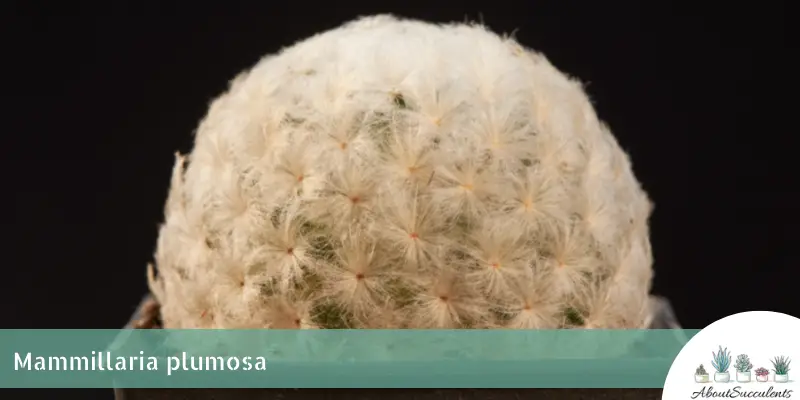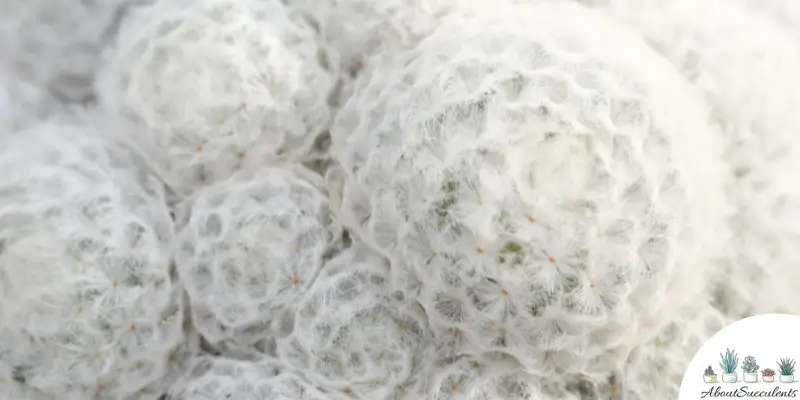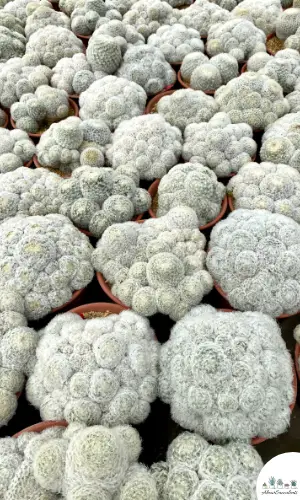
Mammillaria plumosa more commonly known as Feather Cactus is a clustering cactus that grows spherical stems covered with white, feather-like spines.
The long hairs of the spines are arranged in the same manner as the bird’s feather. These unique-looking spines protect the Feather Cactus from the heat and sun.
This low-growing cactus plant reaches up to 12.5cm (5”) in height and up to 40.6cm (16”) in cluster width. Each globose stem grows up to 7cm (2.8”) wide. The stems are light-green in color but appear white because they are fully covered by feathery spines.
During summer, a ring of ivory, yellowish-white or pink flowers appear around the top of the cactus. These daisy-like flowers grow up to 1.5cm (.60”) long and give off a strong sweet scent.
Although this eye-catching succulent looks fluffy, it is not soft to touch. Handle it with care because underneath the surface spines are the younger and pointed spines that are quite sharp.
Mammillaria plumosa hails from Nuevo Leon, Mexico. It belongs to the Mammillaria genus of the Cactaceae family.
General Information:
Also known as: Feather Cactus
Plant Family: Cactaceae
Origin: Nuevo Leon, Mexico
Height: 12.5cm (5”)
Exposure: Indirect Bright Light
Water Needs: Drought-resistant; Use the “soak and dry” watering method
Soil Type: Cactus mix combined with gritty materials such as coarse sand, fine gravel, perlite, or pumice.
Soil pH: 6.1 to 7.5
How to Grow and Care for Mammillaria Plumosa

Mammillaria plumosa does not require plenty of attention and care to grow well. It is not as delicate as it looks and with proper care, you will be able to keep your Feather Cactus for years indoors or outdoors.
They are eye-catching accents for your container, rock, or cactus gardens.
Mammillaria plumosa prefers warm weather. The best temperature to grow it is 18.33°C – 32°C (65°F – 90°F). It is not cold-hardy and temperatures below 6°C (20°F) will kill it.
Sunlight
Mammillaria plumosa needs plenty of bright light to grow well. After you buy a young cactus remember to acclimate it first. Expose it to indirect bright light before you transfer it to a full sun location.
If Feather Cactus is planted outdoors, choose a location where it can get indirect sunlight in the morning and shaded light in the afternoon for 5 to 6 hours. Direct exposure to intense light will cause your succulent to turn yellow.
It’s not recommended to grow Mammillaria plumosa in a fully shaded location, it will have fewer spines and lose its bluish-green hue.
As an indoor-potted succulent, place the cactus near a window facing south or west. Get a grow light if you live in a place that does not have plenty of bright light.
Watering

Excessive watering will rot the roots of your Feather Cactus. During Summer, water your cactus every two to weeks.
If you live in a humid area, water your succulent every six weeks. During winter, you can suspend watering because the soil retains moisture longer.
Use the “soak and dry” method to prevent your Mammillaria plumosa from sitting in water for too long.
Make sure that the soil is completely dry between waterings. You can test the soil’s dryness by inserting your finger or stick into the soil. Do not drench the spines with water as it will affect their fluffy appearance.
Pot and Soil
The ideal pot to house your Mammillaria plumosa is one that is either made of terracotta or ceramic and has a drain hole with a mesh net at the bottom. This type of pot will support the conditions for the soil to dry out right way.
The proper size of the pot is 10cm – 15cm (4” – 6”) so that there is enough circulation of air in the soil and for the roots to have room to grow.
Use a well-draining cactus or succulent mix for good root aeration and drainage. Combine 30% cactus soil and 70% mineral grit such as pumice, sand, gravel, or perlite.
If you will plant your Feather Cactus outdoors, add plenty of grit such as fine gravel or coarse sand into the soil for good drainage.
You can give your soil a weak feeding of liquid fertilizer made for cacti or succulents, once at the start of spring and again in midsummer.
How to Propagate Mammillaria Plumosa
It’s easy to add to your collection of Woolly Rose. You have 2 methods for propagating this beautiful succulent – Stem Mammillaria plumosa can be propagated by using offsets, and seeds from the parent plant. The best time to remove offsets and plant seeds is in summer and spring.
Method 1: Offsets
Step 1: Check the base of the mother plant for offsets that form in clusters.
Step 2: Gently remove the offsets with a sterile, sharp knife, clean tongs, or sterile razor blade.
Step 3: Place the offsets in a dry and warm area. Leave them for 2 to 3 days and let them callus over.
Step 4: Place the offset in terracotta or ceramic pot filled with cactus or succulent soil mixed with perlite, coarse sand, or pumice.
Method 2: Seeds
Step 1: Fill a pot or seed tray with cactus mix combined with perlite, coarse sand, or pumice. Water the potting mix thoroughly, leave the pot for some time and allow the water to decant.
Step 2: Scatter the seeds all over the soil. Mist the seeds with water and cover the container with plastic. Place it in a warm area.
Step 3: Remove the plastic cover when the seedlings sprout and place it in an area where it gets indirect sunlight for a few minutes a day.
Step 4: Select strong seedlings and transplant them in pots filled with well-draining soil mixed with gritty materials.
Frequently Asked Questions
Is Mammillaria Plumosa Toxic to Cats and Dogs?
Mammillaria plumosa is not listed as toxic to cats and dogs on the website of the American Society for the Prevention of Cruelty to Animals (ASPCA). However, it is best to keep it out of the reach of your children and pets because the spines can hurt them.
Why is My Fresh Cactus Dying?
Your Mammillaria plumosa could be dying because of 2 possible reasons: overwatering or pest infestation.
Overwatering
Overwatering can damage the roots of your Mammillaria plumosa. You need to act quickly to prevent root rot from progressing to fungal infection.
Gently remove the succulent from the pot and brush off the soil clinging to the roots. Cut the rotted or dead roots with a sterile knife or shears.
Place the plant in a new terracotta or ceramic pot filled with fresh cactus mix combined with gritty materials. Allow the soil to dry out before watering.
Pest Infestation
Mammillaria plumosa is prone to mealybugs and scales infestation. These pests are difficult to detect because of the spines covering the plant.
Once you see signs of pest infestation on your Feather Cactus, spray your plant with neem oil or wipe its leaves with a cotton ball soaked in a solution of 70% alcohol.
Does Mammillaria Plumosa Produce Flowers?
Yes, Mammillaria plumosa produces off-white, greenish-white, or pink funnel-shaped flowers during summer. These flowers form a ring around the stem.
Last Updated on June 9, 2022 by Sofia Lara